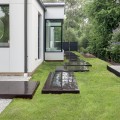Beautiful Garden Design

We have all seen a garden that we would call beautiful, but what does beautiful garden design mean when it comes to professional landscaping design?
Proportion is the most notable feature of professionally designed gardens.
Proportion is present on many levels. It is present within garden boundaries in the form of elements whose size and position create a symmetrical presentation. A balance of inorganic and organic elements is always sought in order to give the garden a deliberately manmade look that is simultaneously rich in organic vitality.
Beautiful garden design also pays close as much attention to what surrounds the garden as it does to what is within the garden.
Surrounding trees, hardscapes, pools, patios, walkways, and even the home itself all work together to form a comprehensive landscape theme into which the garden fits as a part.
Along with proportion, a beautiful garden design must also be incorporate accessibility into its presentation.
Without accessibility, a significant portion of the garden’s beauty will be out of the line of sight for the viewer. It is essential that we create varying means of getting the viewer close enough to the garden so they experience its fullness from an optimal vantage point.
Smaller gardens are often planted near gathering areas around patios, gazebos, and arbors. Guests seating or standing in these zones of interest can overlook a lighted planting and enjoy its rich presentation throughout the night.
In many cases, gardens are large enough that the best vantage points are from within the greenery itself. Pathways that cut through the garden, or seating areas within it, let people enjoy the garden from the inside out.
Color is another attribute that is vital to beautiful garden design.
When we say color, we are not talking about the colors of flowers alone. Flowers are important to many styles of gardening, such as the English garden, but they are not the primary source of color at hand.
When we think of life, we think of the color green, because that is the color of plants and tree leaves. Green, as the foundational color of organic life, must also be the foundational color of a garden. Amateur gardens can quickly be recognized by their departure from this principle.
Simply seeking to create a burst of rainbow colors by planting as many different flowers as possible, they forget to lay the foundation and end up overwhelming the eye with a starburst of color patterns.
Professional garden designers, on the other hand, create gardens made of many shades of green. Darker greens convey a more formal and controlled look. They are ideal for both formal gardens and contemporary garden design. Lighter greens suggest growth and vitality and are popular in tropical themes, southern themes, and custom garden design.
A truly beautiful garden design will proportionally combine varying shades of green in patterns and layers that create a rich organic geometry complimentary to home and landscape design.
Flowers can then be added to create a controlled spectrum of expression. Sometimes, however, only one color of flowers is used for the purposes of supporting a specific style, or for the sake of a more conservative presentation.


